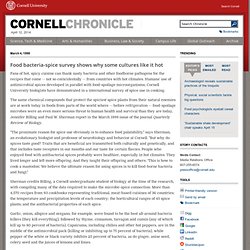

Study: Antibacterial spices in food. Fans of hot, spicy cuisine can thank nasty bacteria and other foodborne pathogens for the recipes that come -- not so coincidentally -- from countries with hot climates.

Humans' use of antimicrobial spices developed in parallel with food-spoilage microorganisms, Cornell University biologists have demonstrated in a international survey of spice use in cooking. The same chemical compounds that protect the spiciest spice plants from their natural enemies are at work today in foods from parts of the world where -- before refrigeration -- food-spoilage microbes were an even more serious threat to human health and survival than they are today, Jennifer Billing and Paul W.
Sherman report in the March 1998 issue of the journal Quarterly Review of Biology. "The proximate reason for spice use obviously is to enhance food palatability," says Sherman, an evolutionary biologist and professor of neurobiology and behavior at Cornell. "But why do spices taste good? 1. 2. 3. 4. 5. 6. Fiery Foods and Barbecue SuperSite - Why Cooks Spice Up Their Foods. Why Cooks Spice Up Their Foods There are a number of explanations for why we have added spices such as chile peppers to our foods over the tens or hundreds of thousands of years that we have been cooking.

They are: Spices make foods taste better. The "eat-to-sweat hypothesis"–eating spicy foods makes us cool down during hot weather. Arsenic in drinking water. Arsenic. Arsenic is a chemical element with symbol As and atomic number 33.

Arsenic occurs in many minerals, usually in conjunction with sulfur and metals, and also as a pure elemental crystal. It was first documented by Albertus Magnus in 1250.[5] Arsenic is a metalloid. It can exist in various allotropes, although only the gray form has important use in industry. The main use of metallic arsenic is for strengthening alloys of copper and especially lead (for example, in car batteries). Arsenic is a common n-type dopant in semiconductor electronic devices, and the optoelectronic compound gallium arsenide is the most common semiconductor in use after doped silicon. Arsenic is notoriously poisonous to multicellular life, although a few species of bacteria are able to use arsenic compounds as respiratory metabolites.
Characteristics[edit] Physical characteristics[edit] Crystal structure common to Sb, AsSb and gray As Isotopes[edit] Inexpensive Arsenic Filtration System Uses Cattails, Aquatic Weeds – Blue Living Ideas. Purification Published on July 15th, 2009 | by Derek Markham An environmental and civil engineer has developed an inexpensive arsenic filtration system that uses aquatic plants, namely cattails, to remove poisonous arsenic from drinking water, which could improve the health of millions in countries around the world whose local water supplies are naturally contaminated with the toxic substance.

An estimated 57 million people are drinking groundwater with arsenic concentrations measured above the World Health Organization‘s standard of 10 parts per billion. Jeremiah D. Jackson, Ph.D., P.E., of San Diego, CA, says he started his research after his brother, a journalist, mentioned the dire need for filtering the arsenic from groundwater in countries such as India, Pakistan, Mexico, and even parts of rural U.S.
Jackson set up an experiment on his patio, with cattails planted in sand in five-gallon buckets filled with water. “The cattail actually thinks the arsenic is a nutrient. Inexpensive Arsenic Filtration System Based on Cattails Could Help Clean Up the Drinking Water of 57 Million People. Photos: Jon Clark/Flickr, CC Awesome Discovery!

According to the World Health Organization's fact sheet about arsenic in drinking water, there are between 46-57 million people globally who are exposed to levels of arsenic higher than the "safe" 0.01 mg/l. Many of those are in poor countries where expensive filtration systems are out of reach, which is why Jeremiah Jackson's invention is so important! The civil and environmental engineer created a cheap filtration system based on cattails, and he didn't patent it so that it is more accessible. Read on for more details on how it works. Community-supported agriculture. Community-supported agriculture (CSA; sometimes known as community-shared agriculture) is an alternative, locally-based economic model of agriculture and food distribution. A CSA also refers to a particular network or association of individuals who have pledged to support one or more local farms, with growers and consumers sharing the risks and benefits of food production.
CSA members or subscribers pay at the onset of the growing season for a share of the anticipated harvest; once harvesting begins, they receive weekly shares of vegetables and fruit, in a vegetable box scheme. Often, CSAs also include herbs, honey, eggs, dairy products and meat, in addition to conventional produce offerings.In theory a CSA can provide any product to its members, although the majority of CSA operations tend to provide produce, fruits, and various edibles. Some CSA programs also include cut flowers and various ornamental plants as part of their weekly pickup arrangement. History[edit] Structure[edit] Farmigo: Removing The Pain of Running a CSA. We are right in the middle of prime growing season for farms in the northern hemisphere.

For an increasing number of people, that means signing up to get produce directly from farmers via CSAs. On paper, it sounds like a good thing: Consumers get fresh, local produce, often exactly what they specify. It’s typically organic. The food miles compared to typical store bought produce are drastically reduced. But there’s a problem: It’s quite cumbersome for farmers to manage a CSA program. Somebody ends up doing most of the work keeping the CSA going, keeping them away from doing what they enjoy most: working the land. I know I’ve often shied away from CSAs, since they often require an upfront payment, often several hundred dollars. You as a customer can locate and choose your pickup point via a map generated based on your location and get directions to the pick-up spot.
Readers: Are you a farmer? Scroll down to see comments. Farmigo CSA Management Solution.